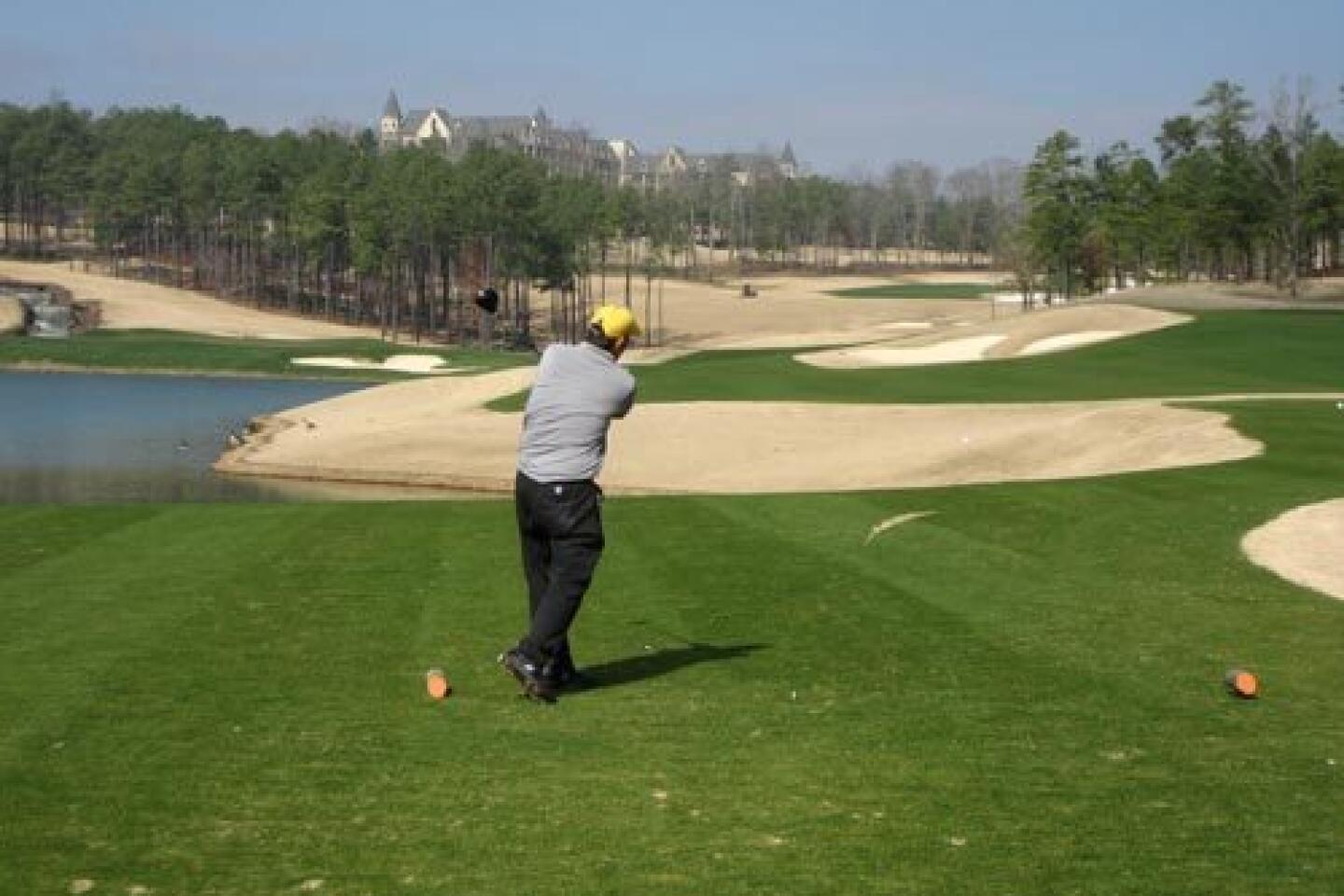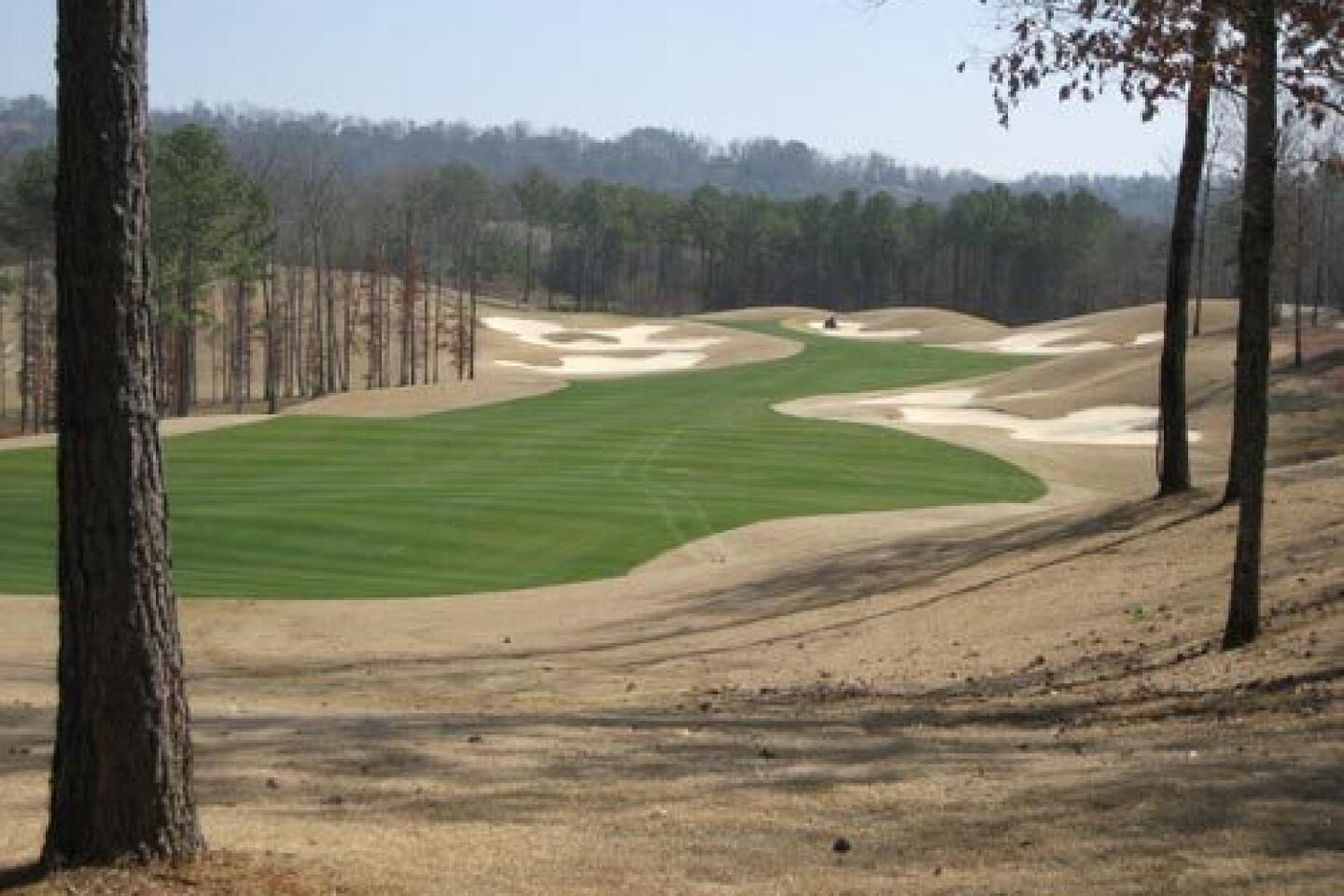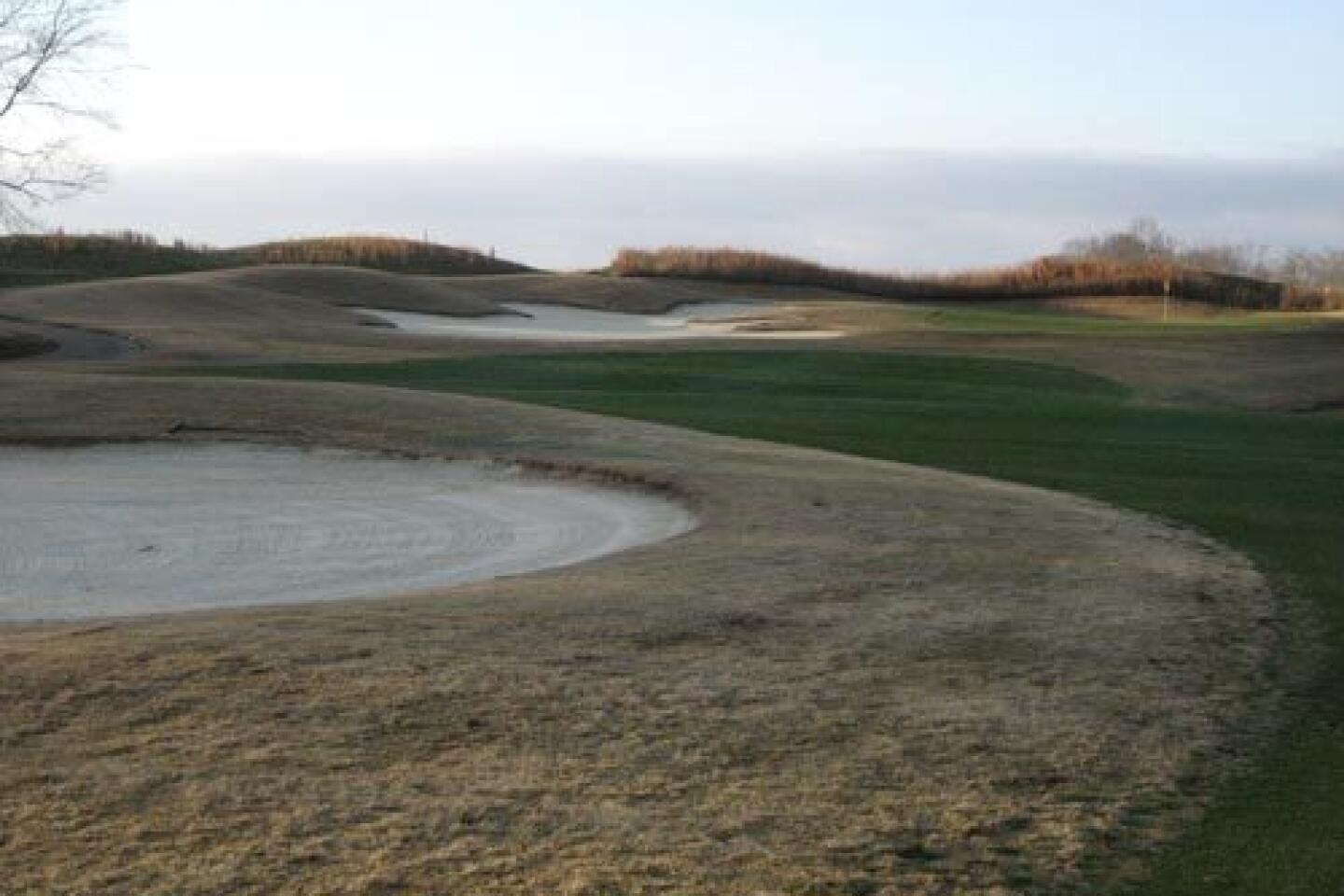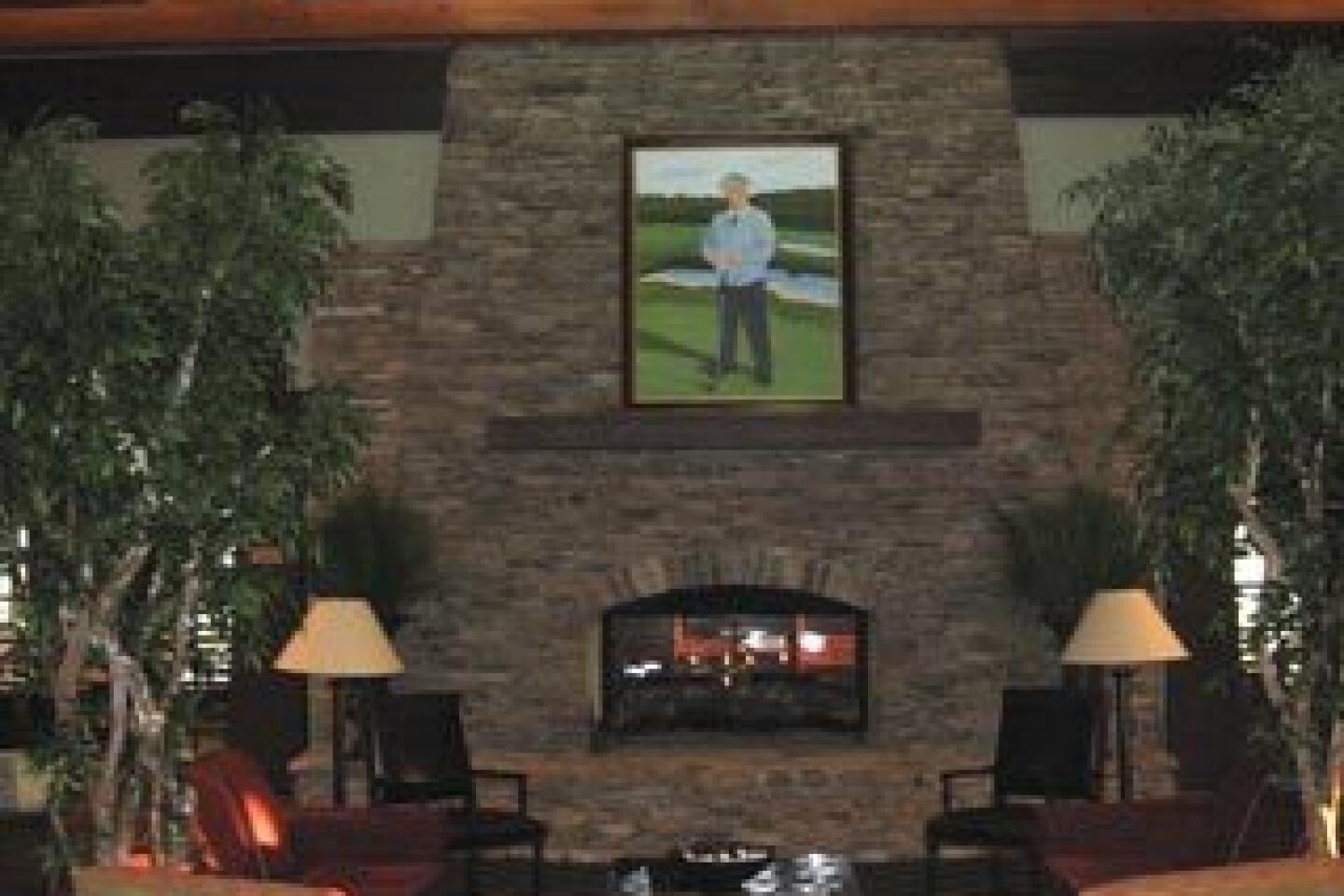Alabama’s Robert Trent Jones Golf Trail is a full-course feast
- Share via
Huntsville, Ala.
The National Golf Foundation, which tracks trends throughout the industry, considers an avid golfer to be anyone who plays eight rounds a year. I’m not sure what that means my three friends and I are. Fanatic? Obsessive compulsive? Nuts?
Four of us recently returned from a trip to Alabama’s incomparable Robert Trent Jones Golf Trail, a collection at 11 sites of 26 courses whose beauty can steal your breath and whose difficulty can shred your pride. We essentially played twice a day for six days, 50 holes one day because we had a little extra time between our two scheduled rounds, only 18 on another when the weather was more suited to the Iditarod than golf. Our last day, we were limited to one round so we could make our flight back; it seemed as though we were just getting warmed up before the drive to the airport beckoned.
We started at Oxmoor Valley in Birmingham and Ross Bridge in nearby Hoover, then drove a couple of hours north to Hampton Cove in Huntsville, then the final day and a half at Muscle Shoals near Florence, an hour and a half to the west of Huntsville.
We had played the three courses at Oxmoor Valley before -- the difficult Ridge Course, with its demanding elevated greens; the Valley Course that winds through heavy woodlands and waterways; and the delightful Short Course of 18 distinctive par-three holes. But the real attraction on the first leg of the trip was Ross Bridge, the newest facility on the trail. It is to most golf courses what Yankee Stadium is to a Little League park in Pacoima. It’s massive, built on more than 300 acres -- twice that of most traditional layouts -- with huge greens, bunkers where Lawrence of Arabia might get lost and fairways wide enough to land the Space Shuttle, which, by the way is resting just up Interstate 65 at the U.S. Space & Rocket Center in Huntsville.
“We wanted a wow factor with Ross Bridge,” says Bobby Vaughan, who along with architect Roger Rulewich -- Jones’ right-hand man until the noted designer died in 2000 -- has helped draw up and build the trail courses from the start. “We wanted people to step up to the first tee, look out over the course and just say, “Wow!”
That was exactly what he got from the four of us. It didn’t take long to realize we were playing a course fertilized with HGH. From the back tees, it measures an incredible 8,191 yards, though with five sets of tees, it can be as short as 5,312. We had no intention of playing from the tips, something like playing a game of H-O-R-S-E on a basketball hoop 40 feet high. We chose the middle tees, which was plenty to handle.
“Everyone has been overwhelmed by the place, by its vastness, the gigantic scale,” Rulewich says. “I’ve heard stories of a couple of Englishmen who flew over just to play the back tees. They got beaten up pretty good . . . but they loved it.”
Interestingly, the course plays largely downhill, from elevated tees that leave the holes right in front of you with no tricks or blind shots. Each hole is nicely framed by stands of majestic pines, and there are homes (large, of course) around much of the course, but they’re never intrusive.
Ross Bridge was the first course on the trail designed specifically as a tournament course, the scale to accommodate spectators, giving them room and providing vantage points to see the competition. The Regions Charity Classic, a $1.7-million Champions Tour event, is held there each May.
The pro shop is at one end of the Renaissance Ross Bridge resort, a high-end, full-service spa and hotel without the high-end price. The lounge next to the pro shop was listed among the nation’s best 19th holes by Golf Digest. Larry, one of our foursome, grabbed a turkey sandwich to go just before one of our rounds. It was built to scale too.
We scouted out the hotel after our second round at Ross Bridge and were flagged down by Lisa, the concierge, who noticed that we seemed to be lost. We told her we were looking for a good local restaurant for the evening, and though we told her we weren’t staying in the hotel, she booked us a table at the Bright Star in nearby Bessemer, a charming seafood and steak restaurant that opened in 1907.
“Make sure to tell them I sent you over,” Lisa told us. “You’ll get a free bowl of gumbo.”
We arrived at 6:30 for dinner, were greeted like heads of state, and had our gumbo delivered as soon as we were seated in the red leather and aged-wood booth. We’ve found on each of our four trips to the trail that the magnificence of the golf courses is matched only by the hospitality of our hosts wherever we’ve been.
Our third day in Birmingham, we played the 50 holes during an occasional drizzle and dropping temperatures. By the time we finished playing, our feet were wet and it was in the low 40s.
Then the weather turned. Day 1 in Huntsville: 31 degrees and windy. We got to the course, began playing in 26-degree wind-chill and endured 18 holes on the Highlands course, which this spring will be closed to renovate it to its original links-style design. On the sixth green, it began snowing . . . sideways. The snow never seemed to hit the ground, blown horizontally by winds gusting to 25 mph.
My friend Steve, a sports copy editor at The Times, walked off the 16th green and said, “I can’t feel my chin.” Then to no one in particular he announced, “Doc, I’m ready for my root canal.” By the time we finished, the temperature had climbed to 33.
Our final four days were spent in the northern part of the state, highlighted by the two 4-year-old courses at Muscle Shoals: the Schoolmaster and the Fighting Joe. Both courses are nearly on a similar scale to Ross Bridge, Fighting Joe a links-style layout virtually without trees, with holes separated by the land’s contours and tall fescue grass, the Schoolmaster a rolling, wooded layout with each hole bordered by stands of tall oaks. There is enough water on each course to keep golf ball sales brisk in the pro shop. We played 36 holes on the Schoolmaster in the rain, the courses to ourselves as they had been much of the week.
Then on Saturday, our final day, the sun shone for 18 holes on the Fighting Joe. I tried to take as much time as possible between shots, not ready to fly back to Southern California after only one round of golf. But I couldn’t stop time, and the 18th hole, with the spectacular backdrop of the Tennessee River, brought to an end a week that had passed much too quickly.
More to Read
Sign up for The Wild
We’ll help you find the best places to hike, bike and run, as well as the perfect silent spots for meditation and yoga.
You may occasionally receive promotional content from the Los Angeles Times.














